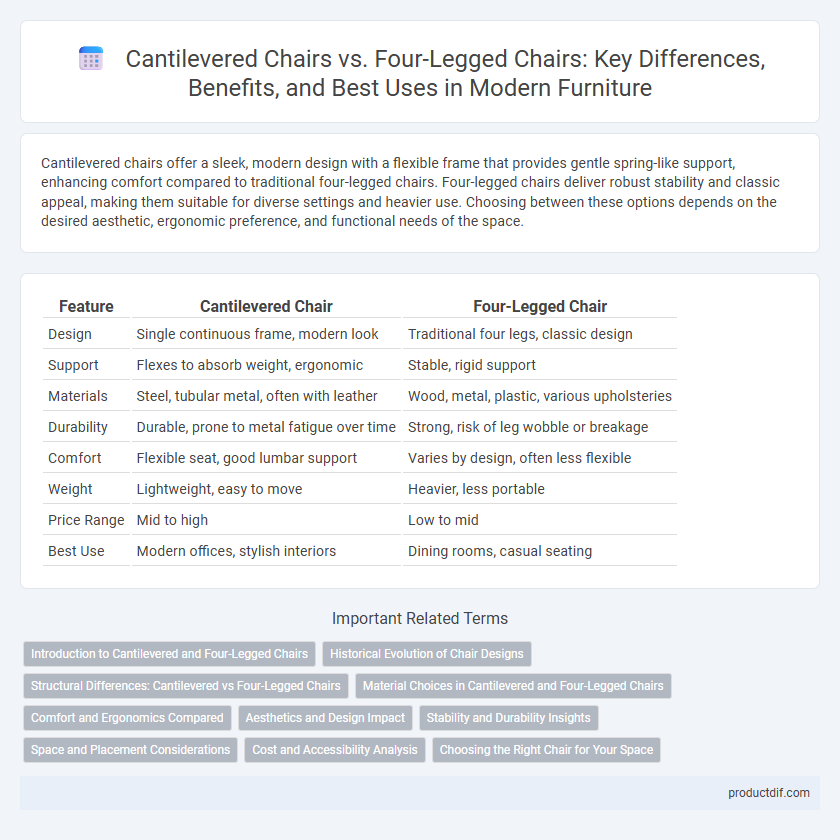Cantilevered chairs offer a sleek, modern design with a flexible frame that provides gentle spring-like support, enhancing comfort compared to traditional four-legged chairs. Four-legged chairs deliver robust stability and classic appeal, making them suitable for diverse settings and heavier use. Choosing between these options depends on the desired aesthetic, ergonomic preference, and functional needs of the space.
Table of Comparison
| Feature | Cantilevered Chair | Four-Legged Chair |
|---|---|---|
| Design | Single continuous frame, modern look | Traditional four legs, classic design |
| Support | Flexes to absorb weight, ergonomic | Stable, rigid support |
| Materials | Steel, tubular metal, often with leather | Wood, metal, plastic, various upholsteries |
| Durability | Durable, prone to metal fatigue over time | Strong, risk of leg wobble or breakage |
| Comfort | Flexible seat, good lumbar support | Varies by design, often less flexible |
| Weight | Lightweight, easy to move | Heavier, less portable |
| Price Range | Mid to high | Low to mid |
| Best Use | Modern offices, stylish interiors | Dining rooms, casual seating |
Introduction to Cantilevered and Four-Legged Chairs
Cantilevered chairs feature a single, curved support structure that provides a modern aesthetic and unique flexing comfort, making them popular in contemporary furniture design. Four-legged chairs offer traditional stability and balance, with evenly distributed support suitable for various settings and styles. The choice between cantilevered and four-legged chairs depends on desired ergonomics, visual appeal, and functional use.
Historical Evolution of Chair Designs
Cantilevered chairs emerged in the 1920s, revolutionizing furniture design with their innovative use of tubular steel and absence of rear legs, inspired by Bauhaus principles. Four-legged chairs date back to ancient civilizations, embodying traditional craftsmanship and structural stability rooted in wood and metal frameworks. The transition from four-legged to cantilevered chairs marks a significant shift towards modernist aesthetics and ergonomic experimentation in 20th-century furniture evolution.
Structural Differences: Cantilevered vs Four-Legged Chairs
Cantilevered chairs feature a single continuous frame that supports the seat without back legs, relying on the strength of bent tubular steel or metal for flexibility and suspension. Four-legged chairs use a traditional quadruped structure with vertical legs at each corner, distributing weight evenly and providing stable, rigid support. The cantilever design allows for slight rocking motions, enhancing ergonomic comfort, while four-legged models emphasize sturdiness and balance on uneven surfaces.
Material Choices in Cantilevered and Four-Legged Chairs
Cantilevered chairs often utilize steel or tubular metal for their frames, providing flexibility and a sleek, modern aesthetic, while four-legged chairs typically employ wood or metal, allowing for a broader range of styles and finishes. The choice of materials in cantilevered chairs supports their distinctive cantilever structure, emphasizing resilience and slight give, whereas four-legged chairs prioritize stability and durability with robust leg construction. Upholstery materials also vary, with cantilevered designs favoring fabrics that complement their fluid form and four-legged chairs accommodating more traditional padding and upholstering techniques.
Comfort and Ergonomics Compared
Cantilevered chairs provide superior ergonomic support due to their flexible frame, which allows gentle rocking and reduces pressure on the lower back, promoting better posture. Four-legged chairs offer stability but often lack the dynamic support that adapts to body movements, potentially leading to discomfort during extended use. Studies show cantilevered seating can enhance comfort by evenly distributing weight and minimizing stress on spinal discs compared to traditional four-legged designs.
Aesthetics and Design Impact
Cantilevered chairs offer a sleek, modern aesthetic characterized by their floating seat design and minimalistic frame, creating an open and airy visual effect that complements contemporary interiors. Four-legged chairs provide a classic and balanced look, often featuring diverse styles from traditional to modern, emphasizing stability and versatile design adaptability. The choice between cantilevered and four-legged chairs significantly influences room dynamics, with cantilevered chairs enhancing spatial perception and four-legged chairs grounding the space with familiar architectural lines.
Stability and Durability Insights
Cantilevered chairs offer flexibility and modern aesthetics but may compromise stability due to their single support base, making them less suitable for high-traffic areas. Four-legged chairs provide superior stability and evenly distribute weight, enhancing durability and making them ideal for daily use in homes or offices. Materials such as steel or hardwood in four-legged designs further increase longevity compared to the cantilevered models often made from tubular steel or plastic composites.
Space and Placement Considerations
Cantilevered chairs offer a sleek design that enhances spatial flow by eliminating rear legs, making them ideal for compact areas and versatile placement. Four-legged chairs provide stable support but require more floor space and careful arrangement to avoid overcrowding. Choosing between these chair types depends on the room's size, layout, and the desired balance between aesthetics and functionality.
Cost and Accessibility Analysis
Cantilevered chairs generally have higher manufacturing costs due to their unique design and use of specialized materials, making them less accessible for budget-conscious buyers compared to four-legged chairs, which are typically simpler and cheaper to produce. Four-legged chairs dominate the market with widespread availability and affordable pricing, benefiting from standardized production methods and common materials like wood and metal. Cost efficiency and accessibility make four-legged chairs preferable for large-scale procurement in commercial and residential settings.
Choosing the Right Chair for Your Space
Cantilevered chairs offer a sleek, modern design and flexible support with their single, continuous frame, ideal for contemporary spaces and smaller rooms where visual openness matters. Four-legged chairs provide stable, classic support and versatility, making them suitable for traditional or high-traffic areas requiring durability and ease of movement. Selecting the right chair depends on your space's aesthetic, usage patterns, and comfort preferences, balancing design innovation with practical functionality.
Cantilevered chair vs four-legged chair Infographic

 productdif.com
productdif.com